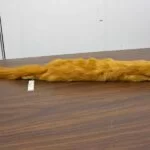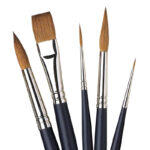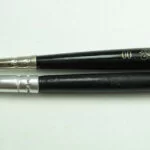Synthetic vs natural brushes For miniatures (covered A-Z)

Every mini painter’s toolkit should include paintbrushes in various shapes and sizes. However, when choosing a miniature paintbrush, the bristles are one of the most important factors to consider.
Miniature paintbrushes like The Army Painter’s brush are made of high-quality synthetic and natural fibers, but they work differently, from their durability to springiness, price, paint capacity, and usage.
In this guide, we compare synthetic and natural hair paintbrushes to know which works best for miniature painting.
What kind of natural hair brushes are there?
Natural hair brushes are not called natural for no reason.
Natural hair Paintbrushes are manufactured with delicate natural fibers derived from animal hair, mostly Ox hair, Siberian Weasels, squirrel, goat, and camel hair.
For instance, brushes like the kolinsky sable have bristles made from the tail of a Siberian weasel, a specie weasel known as Mustela Sibirica. You’ll also find red kolinsky sable brushes with red bristles gotten from the regular weasels.
The hair gotten from these animals features strength, spring, and the ability to retain its shape and snap back, which makes natural paint brushes great for painting.
What kind of synthetic brushes are there?
Synthetic hair brushes are brushes made with synthetical bristles.
So, if you think about synthetic fibers, the material will basically revolve around polyester, nylon, faux, Toray, and Taklon fabrics.
Some good examples of synthetic brushes are the Citadel STC synthetic brushes, Winsor and Newtons Cotman series and the Monument bomb wick brush. These brushes are either made with 100% nylon, or taklon materials. So, they have synthetic bristles.
Differences between natural hair and synthetics
- Durability Of Natural Hair Vs Synthetic
Natural hair brushes are soft and easy to care for. So, they last for years with proper care.
On the flip side, the biggest benefit of synthetic brushes is that they are extremely hard-wearing. As they’re man-made fibers they’re pretty tough and can take a good beating. They are more resistant to fading than natural bristles and can withstand being washed several times thanks to their rubber-like fibers.
However, since they are made with synthetic fibers they can break, curl, and damage easily with wrong use.
- How each of these typese hold paint
The most significant difference between natural hair brushes and synthetic brushes is that natural paintbrushes can hold more paint inside their bristles or belly, just like natural hair. It means you spend less time getting the paint in the brush to use on your miniatures.
On the other hand, natural hair brushes have good water retention and release features thanks to their being obtained from animal hair. This means that they have little imperfections and stuff in the fibers that give them a sponge-like property to hold onto a lot more liquid (water, ink, thinned paint etc.), so you can paint with them long.
Plus, they have a steadier release of that water back out, which means you can control the paint flow more finely to give you more control over the details and a cleaner finish.
However, synthetic paint brushes won’t retain water since nylon fibers only absorb about 10 percent of their weight in water.
- Will Synthetic hold the point like Natural bristles?
Natural brushes will hold the point better. In fact, it can hold a point for many years with proper care.
The shape of natural bristles is good because they come to a natural point, rather than being long cylinders of manufactured fiber that are cut to a point, so they all group together and naturally sit in a really sharp tip.
Some synthetic brushes have a fine pointed tip, but they don’t hold the same point or flexibility as good natural paintbrushes since they are made of synthetic fibers.
- Taking care of each type of brush
Natural hairs can allow thorough washing and conditioning with brush soaps and conditioners thanks to their ability to hold water well.
On the other hand, synthetic brushes are generally more resistant to washing to conditioning since they feel like conditioning a rubber, which won’t really make any impact.
However, if you plan on using mineral spirits to clean the brushes, synthetic brushes are easier to care for.
- ‘springiness’ and stiffness Natural Vs Synthetic Paintbrush
The more bristles in the brush and the wider it is, the more snap and spring it has. Natural hair is very light. Hence, they often fill the paintbrush, giving it more snap and springiness.
It also means that natural hair brushes such as kolinsky sable can easily retain their shape, so you don’t lose control when painting. However, they lack the stiffness that synthetic brushes boast of.
Still, their little stiffness properties mean you can paint with less pressure which can make it easier to do details and you can control the brushstrokes better.
- Will they survive hard use?
Used with acrylic paints, natural hair brushes can damage easily, but synthetic brushes are less prone to damage.
On the flip side, your natural hair brush can maintain its shape and point after painting more than 20 armies, but synthetic brushes won’t.
- Price
Synthetic brushes are less expensive than natural paintbrushes since they don’t require any special obtaining procedure and are easy to get. Natural hair paintbrushes are often handmade, obtained from animal hair, and demand the right professional skill to make them. Hence, they are more expensive than synthetic brushes.
- Source
Synthetic brushes are made without harming hair on an animal’s head. However, the natural bristles of paintbrushes like the kolinsky sable paintbrush are extracted from the tail of a Siberian weasel. So, natural hair paintbrushes are not cruelty-free.
when to use a synthetic brush and when to use natural hair paintbrush
- Priming
Natural hair brushes won’t work well with alcohol-based solvents. So, if you use primers like the Tamiya surface primer, they won’t work well. Only use them for water-based primers.
- Base coat
Natural hair brushes are the best for detail work, but you are best off doing your basecoats with a cheaper or older brush so that they don’t damage easily.
- Dry brushing
Dry brushing with natural brushes means you have to run the pointed tip on your miniature’s surface without water. It can damage the tip of the paintbrush. So, you want to avoid dry brushing with your natural paintbrushes and use synthetic instead.
- Gluing\filling
Gluing or filling parts with a brush means you forgo the normal process of sliding the brush along the side of the model and rather “stab” into corners. This kind of job requires a synthetic brush only!
With the natural paintbrush, you destroy the tips doing this and shorten their lifespan.
Most natural hair brushes like the kolinsky sable won’t work well with oil-based varnish.
Oil-based primers destroy the gentle natural fibers and it will be best to use synthetic brushes for this.
If you still prefer varnishing with a natural fiber brush, hog hair natural brushes can make varnishing with water and oil-based varnish possible.
Natural hair paintbrushes are basically designed for detail work, from highlight to edge highlighting.
The bottom line is that how you use your natural brushes depends on the technique you’re using.
For example, when dry brushing, I’ve yet to see a better brush than a synthetic. I can use a synthetic for base coats, and even some basic highlighting. But I will always use natural brushes for fine details.
Conclusion – synthetic vs natural brushes
Synthetic and natural paintbrushes are good brushes used by experienced and beginner painters for painting their models. However, you won’t get the same quality for both.
The natural paintbrush can last for years, hold its shape better and often come with good pointed tips. Their only drawback is that they are comparatively expensive and derived from animal hairs.
On the other hand, synthetic brushes are made with nylon, faux, toray or taklon fibers. They are cheap but lose their tip after some time. Hence, they demand frequent replacement, which could add up to hundreds of dollars in the long run.





